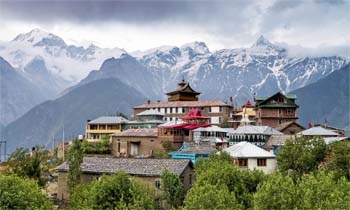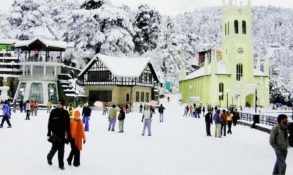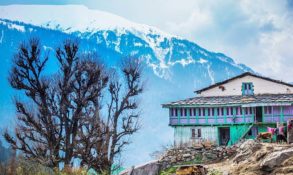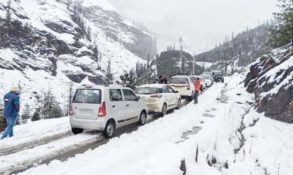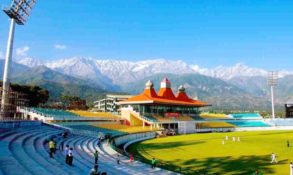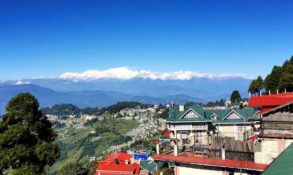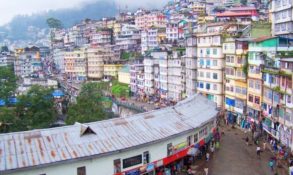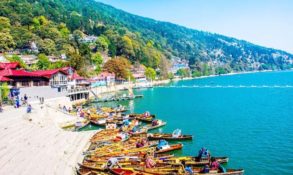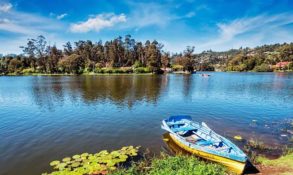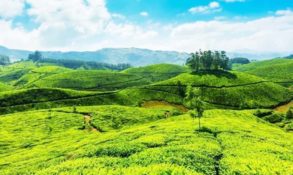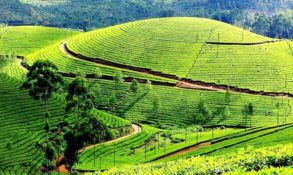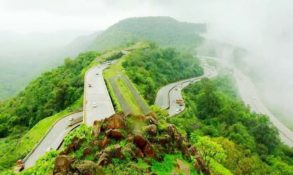A place of rugged beauty, Kinnaur is a wonderland where rivers flow through the plunging Gorges of the Himalayas. The old Hindustan – Tibet highway crisscrossed roads will carry tourists to this secret village called Kinnaur. It is a tiny Indian hamlet where beauty exists and that is why it is known as the “land of fairy tales.” Sharing its eastern border with Tibet, Kinnaur has visible resemblance to Tibetan culture. Three prominent hill-ranges-Zanskar, Himalaya and Dhauldhar-protect the hilltop. Kinnaur’s terrains produce a spell that incites all adventurers to dive into this sorcery. The winters here are very cold but the summers are good. There is no monsoon here, as a dry region. The best time to visit Kinnaur is therefore from May through October.
Hindus are visiting Kinnaur to see the famous Kinner Kailash, believed to be the house of Lord Shiva and the Shivaling rocks, the Pandavas stories and their relation to Kinnaur is a great attraction. In the area there are also old Buddhist monasteries and temples that are of particular significance and are revered by the Buddhists. Besides faith, Kinnaur also has broad variety in adventure sports such as trekking and skiing. There are about nine known trekking routes and some of which are trips of five days or six days. Kinnaur is well known for its delicious apples, chilgoza, handcrafted fabrics and handicrafts. The city, its cultures and citizens can see subtle signs of modernization but the region continues to be clean, pure and magnificently beautiful.
Places to Visit In Kinnaur
Nako –
Nako is situated in the Himachal Pradesh district of Kinnaur, at an altitude of about 3600 m. On the way to Malling Nullah, Nako is located at the east end of Kinnaur Valley, and can be named almost the last attraction. Malling Nullah is situated between Kinnaur and Spiti Valley, and is one of Himachal Pradesh’s most popular travel destinations Nako is situated in the region close to the Tibbetan Border and travelers must therefore be permitted to travel to this area on an internal road. Inner line permits are required for overnight stays in any part of the village Nako for foreign nationals.
As the village in its area is very small, one can easily discover this village’s hidden gems on foot. Nako Village’s main attraction is the Nako Lake, which lies amid extremely hilly terrain. You can see four Buddhist monasteries near this lake, and a massive footlike impression.
Chitkul –
Chitkul, the last populated village on the Indo-Tibetan border, is located on the bank of the River Baspa. It is India’s last point before one can fly without a permit. The village is a great refuge for travelers looking for a break from crowd and disorder, and transforming into a great paradise for the region’s sparse population. Chitkul’s key attractions are its houses that either have slate or wooden plank roofs. There is also a small Buddhist Temple and a small tower in it. There is a monastery called Kagyupa Temple where a Shakyamuni Buddha age-old image is adorned.
Lipa-Asrang Sanctuary –
Highly recommendable tourist spot for lovers of peace and enthusiastic nature worshipper, Lipa Asrang Sanctuary is about 4,000 to 5,022 m high. The sanctuary stretches over an area of approximately 30.89 sq km. The flora diversity found in this sanctuary includes dry coniferous forest, dry alpine scrub, dwarf juniper scrub, dry broad leaves, temperate forest in the western Himalayas, and coniferous forest.Yak, Leopard, Ibex, Goral, Brown Bear, Blue Sheep, Himalayan black Beer, Musk Deer etc. are the most commonly found fauna in this sanctuary.
Kamru Fort –
Kamru Fort is a historic tourist attraction about 2 km from the beautiful Sangla Valley, located at an altitude of about 2600 m above the mean sea level. The fort, set against a scenic backdrop, exudes breathtaking views of the majestic Himalayas. Crossing a set of gates the fort can be reached. At the main gate the tourists are blessed by a blissful statue of Lord Buddha. The fort encloses a Lord Badrinath shrine from the 15th century. The fort’s wooden balcony serves as an perfect location for experiencing the magnificence of the Himalayan countryside. On the fort’s third floor is an idol of Goddess Kamakhya that was believed to have been brought from Guwahati, Assam. Once every three years a popular fair dedicated to the Deity is organized. During this fair the temple deity is carried to Gangotri, the site of the Ganga River.
Sangla Buddhist Monastery –
The monastery in Sangla Valley, a famous Buddhist pilgrimage to Kinnaur, is located near Reckong Peo in Brelengi. Also known as Brelengi Gompa, the monastery is. The Monastery was founded by the Mahabodhi Society on the occasion of the Kalachakra Festival in 1992. This monastery’s wooden walls and roof are intricately laid out.
Mathi Temple –
Mathi is Kinnaur Local People’s Goddess. There are three temples in the same complex, of which the oldest one is believed to be founded about five hundred years ago by a resident of Garhwal. The temple houses an ark made of walnut wood, which is covered with clothes and a yak tail tuft. Two poles are put into this ark from which to hold it. According to the legend, Lord Badrinath’s wife Mathi once began her journey from Brindavan, and she reached Tibet via Mathura and Badrinath.
Ribba –
Ribba is a populous district village in Kinnaur, located at an elevation of 3745 m above sea level. The village is renowned for the abundance of the Chilgoza or Pine Nut. Ribba is also known as Rirang and it is assumed that the village got its name because of the abundance of Pine Nut, and according to the local dialect, Ri means Chilgoza (Pine nut) and Rang means Mountain top. Ribba is an perfect location for lovers of nature, as it is dotted with orchards and vineyards.
